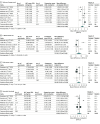Association of Preoperative High-Intensity Interval Training With Cardiorespiratory Fitness and Postoperative Outcomes Among Adults Undergoing Major Surgery: A Systematic Review and Meta-Analysis
- PMID: 37389875
- PMCID: PMC10314310
- DOI: 10.1001/jamanetworkopen.2023.20527
Association of Preoperative High-Intensity Interval Training With Cardiorespiratory Fitness and Postoperative Outcomes Among Adults Undergoing Major Surgery: A Systematic Review and Meta-Analysis
Erratum in
-
Errors in Figure 3 and Supplement.JAMA Netw Open. 2023 Jul 3;6(7):e2327575. doi: 10.1001/jamanetworkopen.2023.27575. JAMA Netw Open. 2023. PMID: 37466946 Free PMC article. No abstract available.
Abstract
Importance: Preoperative high-intensity interval training (HIIT) is associated with improved cardiorespiratory fitness (CRF) and may improve surgical outcomes.
Objective: To summarize data from studies comparing the association of preoperative HIIT vs standard hospital care with preoperative CRF and postoperative outcomes.
Data sources: Data sources included Medline, Embase, Cochrane Central Register of Controlled Trials Library, and Scopus databases with no language constraints, including abstracts and articles published before May 2023.
Study selection: The databases were searched for randomized clinical trials and prospective cohort studies with HIIT protocols in adult patients undergoing major surgery. Thirty-four of 589 screened studies met initial selection criteria.
Data extraction and synthesis: A meta-analysis was performed according to Preferred Reporting Items for Systematic Reviews and Meta-analyses (PRISMA) guidelines. Data were extracted by multiple independent observers and pooled in a random-effects model.
Main outcomes and measures: The primary outcome was change in CRF, as measured by either peak oxygen consumption (V̇o2 peak) or 6-Minute Walk Test (6MWT) distance. Secondary outcomes included postoperative complications; hospital length of stay (LOS); and changes in quality of life, anaerobic threshold, and peak power output.
Results: Twelve eligible studies including 832 patients were identified. Pooled results indicated several positive associations for HIIT when compared with standard care either on CRF (V̇o2 peak, 6MWT, anaerobic threshold, or peak power output) or postoperative outcomes (complications, LOS, quality of life), although there was significant heterogeneity in study results. In 8 studies including 627 patients, there was moderate-quality evidence of significant improvement in V̇o2 peak (cumulative mean difference, 2.59 mL/kg/min; 95% CI, 1.52-3.65 mL/kg/min; P < .001). In 8 studies including 770 patients, there was moderate-quality evidence of a significant reduction in complications (odds ratio, 0.44; 95% CI, 0.32-0.60; P < .001). There was no evidence that HIIT differed from standard care in hospital LOS (cumulative mean difference, -3.06 days; 95% CI, -6.41 to 0.29 days; P = .07). The analysis showed a high degree of heterogeneity in study outcomes and an overall low risk of bias.
Conclusions and relevance: The results of this meta-analysis suggest that preoperative HIIT may be beneficial for surgical populations through the improvement of exercise capacity and reduced postoperative complications. These findings support including HIIT in prehabilitation programs before major surgery. The high degree of heterogeneity in both exercise protocols and study results supports the need for further prospective, well-designed studies.
Conflict of interest statement
Figures



References
-
- Steffens D, Beckenkamp PR, Hancock M, Solomon M, Young J. Preoperative exercise halves the postoperative complication rate in patients with lung cancer: a systematic review of the effect of exercise on complications, length of stay and quality of life in patients with cancer. Br J Sports Med. 2018;52(5):344. doi:10.1136/bjsports-2017-098032 - DOI - PubMed
Publication types
MeSH terms
LinkOut - more resources
Full Text Sources
Miscellaneous

